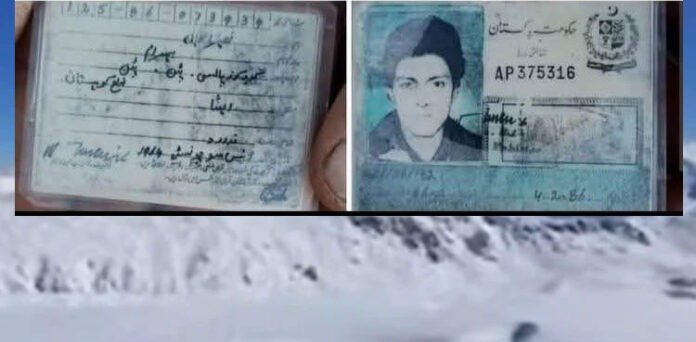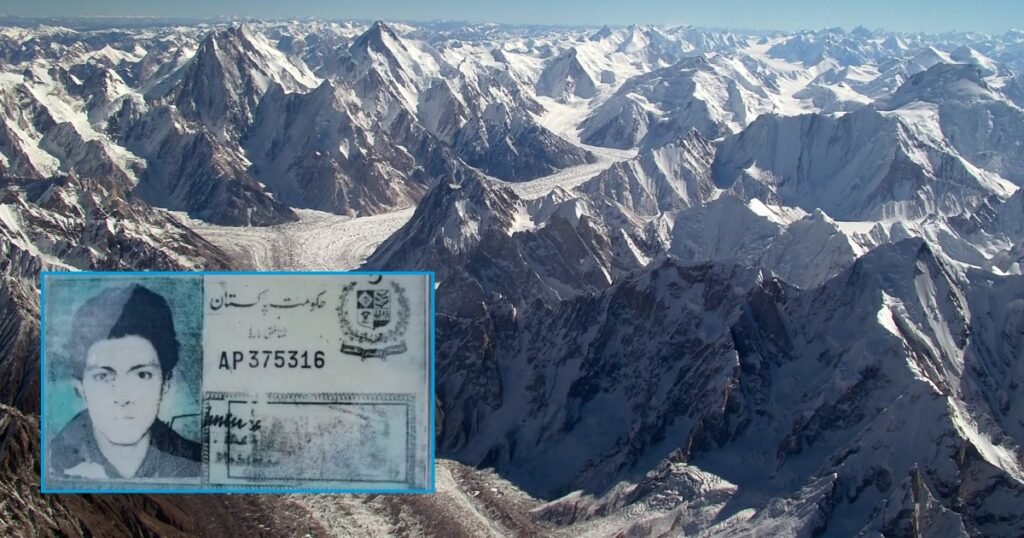In a remarkable twist, Naseeruddin Missing for 28 Years Found in Kohistan Glacier has brought closure to a long‑standing mystery. The Shepherd Umar Khan discovered a frozen human body at the Lady Meadow glacier near Palas, prompting shock and relief among locals. Among the clothing, a National Identity Card confirmed his identity. Experts attribute the preservation to glacier preservation—cold, low humidity, and snow cover that enabled natural mummification over decades. The find rewrote the Man missing for 28 years case, ending years of uncertainty. DNA testing is now underway, offering the family tentative answers at last. For more latest news checkout, Pakistan coverage.
Background
For nearly three decades, a Man missing for 28 years haunted the memory of Kohistan families. Nasiruddin (Naseeruddin) vanished around 1997 during a trek from Sapat Valley disappearance, leaving no trace. His fate long remained a painful unresolved cold case reignited by nature’s slow unveil. His family moved due to threats and internal feuds, leaving their home in Palas. The memory of his disappearance lingered, while locals held symbolic prayers hoping one day for closure. This unexpected discovery merges grief with relief, transforming decades of uncertainty into a solemn moment of reckoning and recognition.
The silence around this Man missing for 28 years ended when glaciers revealed what time had concealed. The glacier’s morphing edges released a frozen human body preserved impeccably by glacier preservation forces. In remote Kohistan Palas region, changing climate exposed long-hidden secrets. The story now blends tragedy with scientific marvel, spotlighting how environmental change can impact forgotten pasts. It highlights the convergence of loss, memory, science, and the slow reveal of secrets frozen beneath ice.
Discovery Details
Then on August 1, 2025, a shepherd named Shepherd Umar Khan trekked the ice fields of Lady Meadow glacier with friends. Unexpectedly, they stumbled on an almost perfect body shimmering at the glacier’s edge. He felt the chill turn eerie when he saw clothing still intact. He realized he had found a Body preserved in glacier—an image locked in time. They recognized a human preserved by cold. That first glance rewrote a 28-year mystery with visceral clarity.
Local authorities responded promptly and secured the site in Palas region. The community whispered about the astonishing find. The intact clothing looked recently donned. The body’s position startled them. They knew that the glacier, once covered, now served as nature’s archive melting glacier reveals remains. The once invisible grave transformed into a public revelation. News outlets described how the ice served as a time capsule revealing decades-old secrets. To get all the latest news, click here.
ID Confirmation
Remarkably, a National Identity Card found in a pocket revealed the name Nasiruddin (Naseeruddin). Officials instantly flagged Identity confirmed via ID card as a key lead. Local police said it likely matched the long-missing man’s documents. A DNA test pending confirmation is now underway. They stressed that confirmation must await forensic results. Family visits occurred soon after, with cautious optimism. The card’s presence changed speculation into near certainty as investigators prepared final validation.
Preservation Factors
Glacial scientists explain that extreme cold, near-zero humidity, low oxygen, and steady snow cover cause Natural mummification inside glaciers. In this case, the glacier preservation process protected skin, fabric, and facial features remarkably well. Dr. Muhammad Bilal at COMSATS explains how internal glacier chemistry and stable thermal conditions shield remains for decades. The body stayed intact because the glacier acted as a refrigerator for 28 years—a silent witness to time’s passing until climate conditions thawed the secret.
Legal & Family Context

Behind the disappearance lay family turmoil tied to honor disputes and regional conflict. After Nasiruddin went missing, his younger brother Gardezi was killed, forcing the family to migrate from Palas. Brother Kaseeruddin recounted that threats and gunshots chased them across mountain trails. They endured dangerous routes avoiding hostile groups. They held vigil for years in hiding. This family history sheds light on why the search stalled and why the disappearance remained unsolved until the glacier did its work.
Legal paperwork followed the glacier recovery. Authorities formally documented the event and notified next of kin. The family, including Kaseeruddin, faces sensitive decisions: whether to bury remains at the glacier site or repatriate them to ancestral grounds. Officials await the DNA test identity results before authorizing any burial. They warned that no public announcement or ceremony will occur until all verification steps are complete to ensure respect and legality.
Reactions & Responses
Locals expressed deep sorrow and surprise. Elders revisited haunting memories. Family received a mix of grief and relief. One relative said, “For 28 years we lived with questions… now at least we have answers.” That sentiment captured both loss and closure. The village gathered quietly, remembering Nasiruddin’s fate. They felt the shock of the discovery and the strange peace it brought.
Authorities urged calm. They requested patience until forensic confirmation arrives. Community leaders emphasized dignity in handling the remains. Media spotlight discussed the rare nature of the remote mountain discovery. They described how climate altered chance. Scientists and officials reminded the public this case reflects broader issues in climate driven glacier retreat and archival exposure of long-lost stories. Explore top world stories and global updates, click here.
Process & Next Steps
Officials documented the glacier site, took photographs and preserved evidence. They recorded coordinates and climate conditions at Lady Meadow glacier. Forensic teams collected samples and sent remains for DNA testing. The family awaits results to decide burial location. Officials said they will hold no press brief until identity is confirmed.
Meanwhile, environmental and rescue agencies will map other melting glacier zones. They plan to train local rangers to report remains or artifacts revealed by warming ice. This marks a formal framework for future cases. It combines forensic protocol with environmental awareness and respects local customs.
Implications & Climate Angle
This remote mountain discovery highlights that climate change glacier melt is exposing artifacts once thought lost. It raises questions about unearthing more Man missing for 28 years type mysteries, and even historical artifacts. Scientists warn that Pakistan’s northern glaciers will continue retreating—potentially revealing more human remains or archaeological treasures.
The case serves scientific, ethical and environmental purpose. It underscores how warming trends unlock archives beneath ice, urging us to consider policies for rescue, recovery and respectful burial. It may change how authorities handle missing person reports in glacier zones. And finally, it highlights how nature sometimes offers answers where human efforts fail, only after decades entombed in ice.
Frequently Asked Questions (FAQs)
How was the missing man found after 28 years?
A local shepherd, Umar Khan, discovered a remarkably intact body on the Lady Meadow glacier, ending the Man missing for 28 years found story.
Who was identified from the glacier find?
Officials found a National Identity Card with “Naseeruddin,” confirming identity confirmed via ID card.
What preservation process saved the body for decades?
Glacial conditions—extreme cold, low humidity, low oxygen, and snow cover—caused natural mummification and Body preserved in glacier.
What is the current status of confirming identity?
Authorities started a DNA test pending confirmation to officially verify the body.
How did family members feel about the discovery?
Family expressed grief mixed with relief, saying they now feel emotional closure for family after decades.








